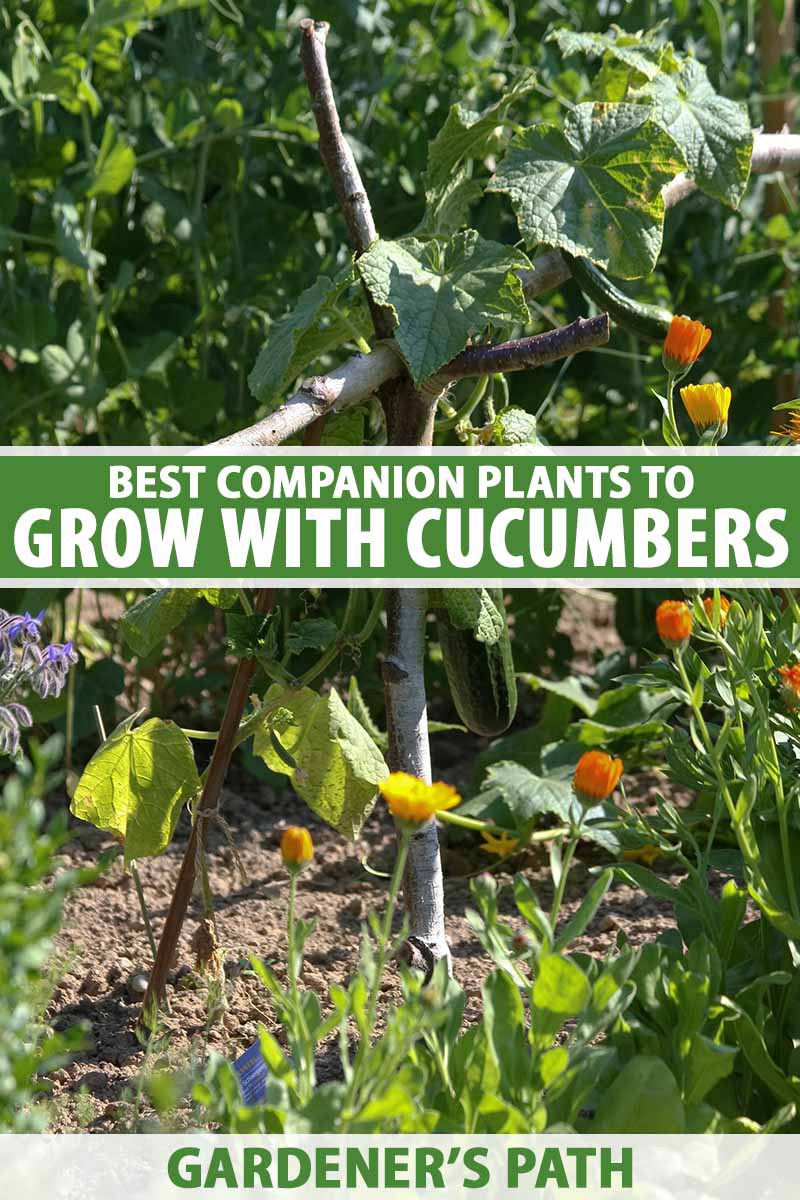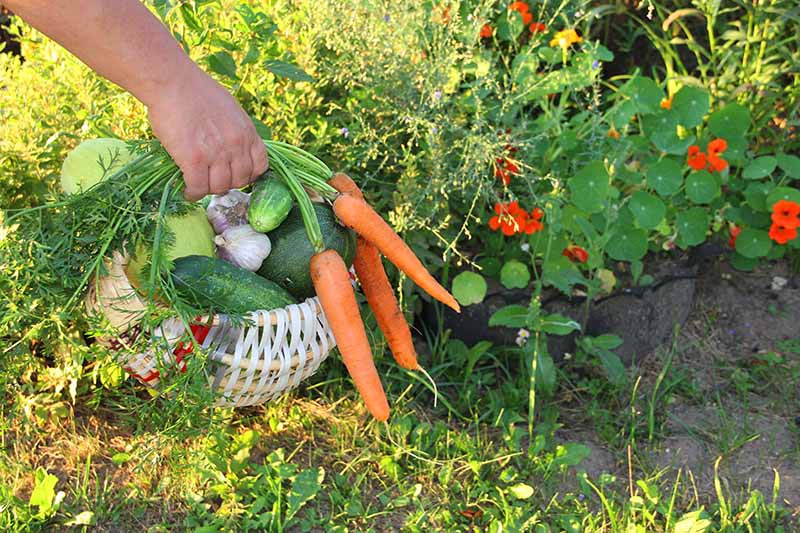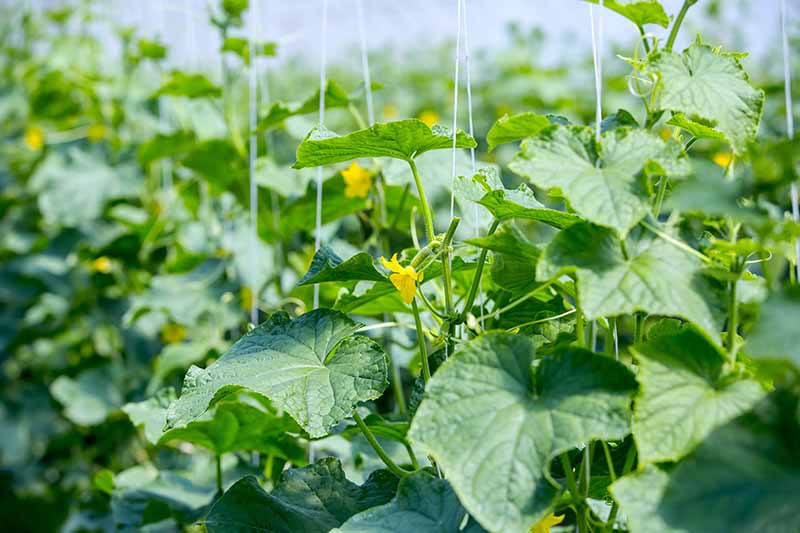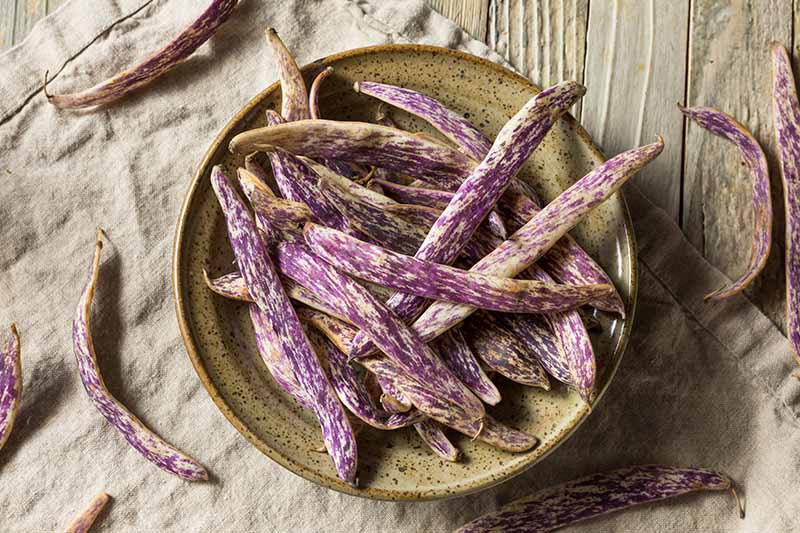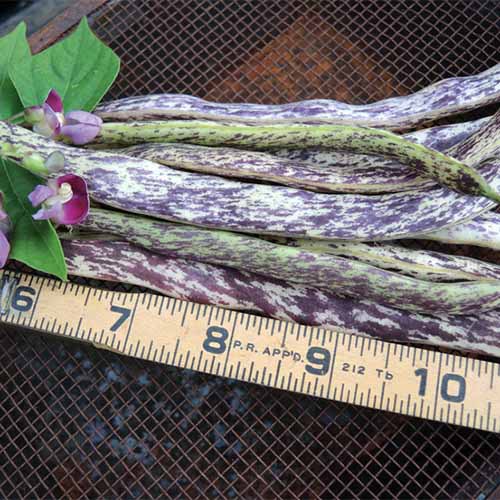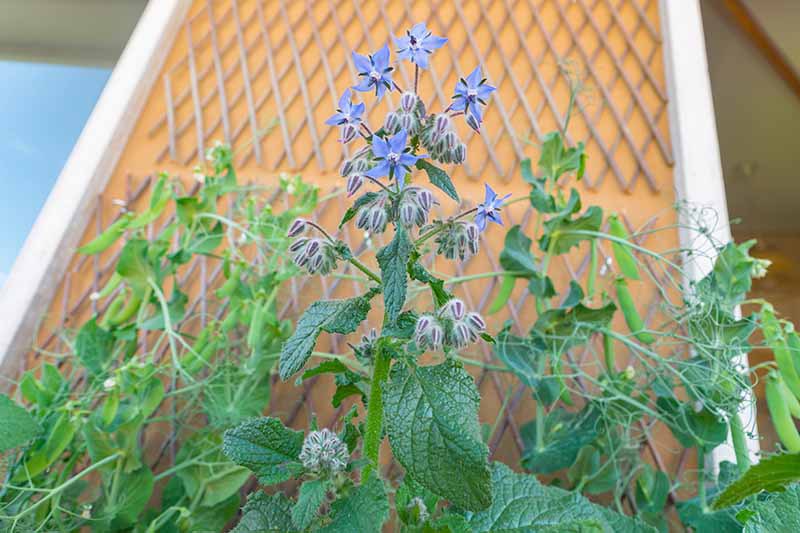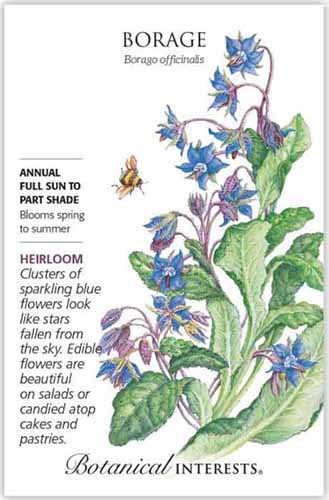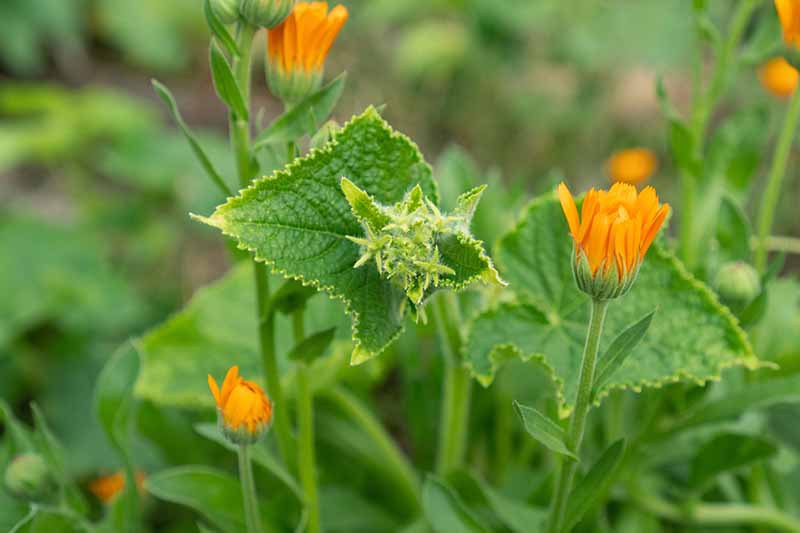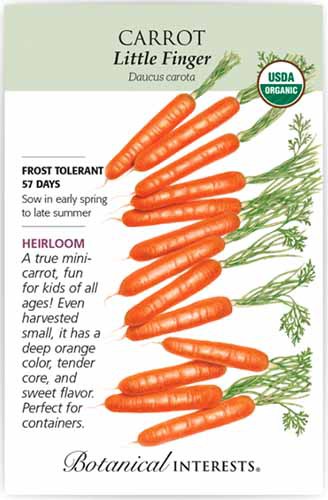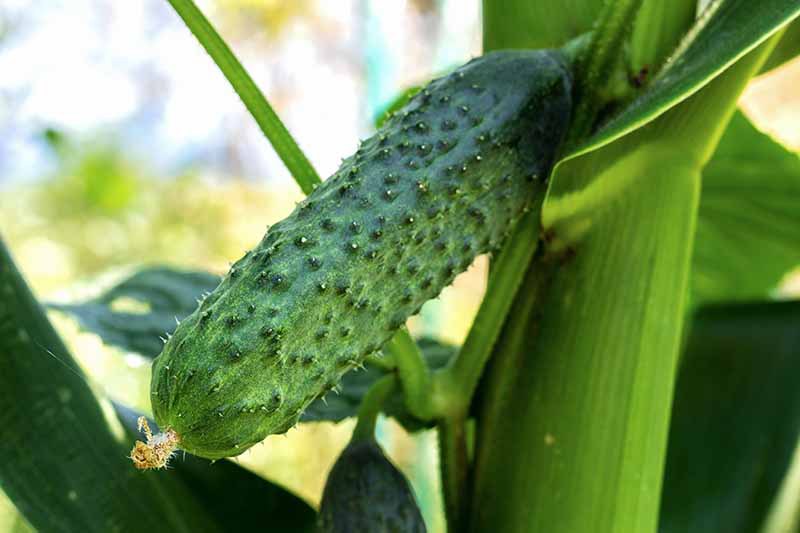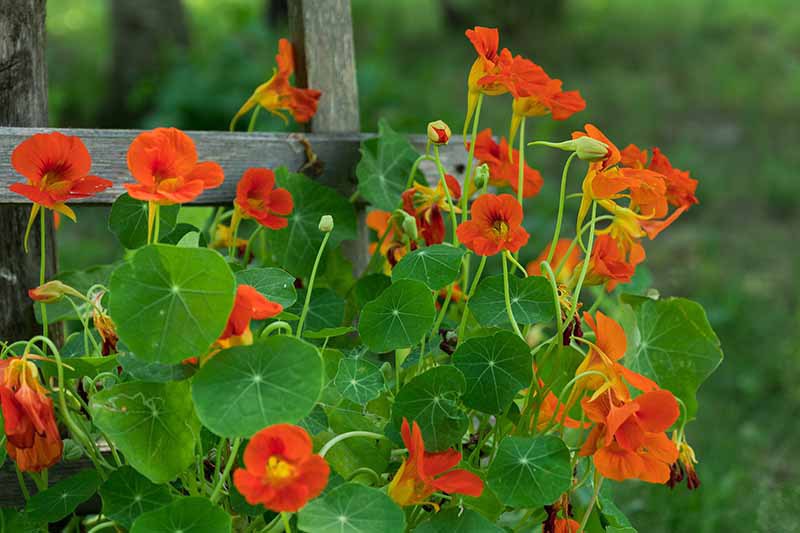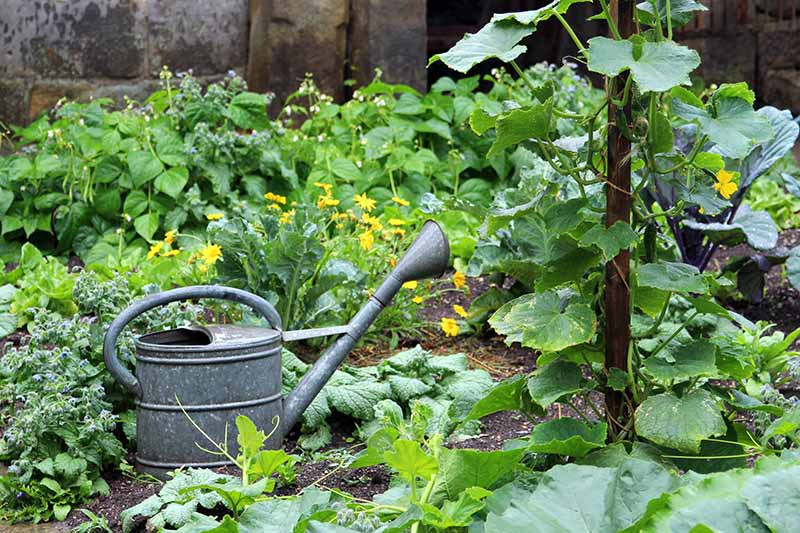Cucumbers, Cucumis sativus, definitely play that role. But if you’re wise, you can make them healthier, happier, and more productive by choosing proper companions as supporting players. This idea of companion planting is part science, part shared lessons handed down from home gardener to home gardener. The basic idea is to intently plan your garden spaces so plants that benefit each other end up growing close together – and those that aren’t able to get along don’t have to. We link to vendors to help you find relevant products. If you buy from one of our links, we may earn a commission. While this is a great idea in any growing space, I think you’ll find it really makes sense when you’re trying to grow a bumper crop of cukes. Just a little support from another plant can increase yields and pollination levels. Sometimes, the other plant is the main beneficiary, which is okay, too. I will mention that many of these ideas are centered on garden wisdom, not hard research conducted in a lab. But I’d encourage you to give them a try yourself and see what works for you. Some companion plants old timers swear by might solve a big issue for you. And the worst case scenario is that you plant a few things you wouldn’t otherwise. No harm done! Let’s get to exploring this concept, and take a look at all the best options. Here’s what to expect:
What Cucumbers Need from Companions
Before I get into specific types of plants, I’m going to take a minute and share the general guidelines for beneficial companions for cukes. In general, the plants should grow well in the same type of soil, and prefer the same pH. To get along with cucumbers, that would mean well-draining soil that’s been amended with plenty of aged organic matter, and a pH of 6.0 to 6.8. As for light requirements, the best neighbors will either share the need for full sun, or benefit from the shade provided by vining vegetables. Since these vegetables are annuals, it’s key that any flowers or herbs grown in the same garden plot be annuals as well. Otherwise, it’s a pain to relocate or work around perennials so you can cultivate your veggie garden in preparation for the following season. You can, of course, opt for perennials, even with the sunflowers I’ll suggest, but plant them nearby or in containers so they don’t mess up your soil prep next year. Keep in mind, too, that there are many different types of C. sativus plant, and the ones you select will impact your choice of companion. Bush varieties, for example, don’t grow so tall they’ll shade other plants. So you can plant them closer to fellow sun lovers, like bush beans, but you can’t rely on them to shade plants like calendula. The bush types spread more than trellised vining varieties, too, so they require more square footage on the ground or in a raised bed. That leaves you fewer opportunities to tuck a few companions like carrots into the nooks and crannies at the base of the plants, the way you can when you’re growing vines on supports. Whether a variety requires pollination to bear fruit also impacts this selection process. You may want to emphasize annual and perennial flowers that attract pollinators, for example, but if you have a parthenocarpic cucumber variety in mind, they won’t need bees to produce. For more information about the different types of cucumber plant, including pickling and slicing, hybrid and heirloom, and distinctions made on whether they require pollination, see our guide. Also, make sure to note how many days it takes each plant to mature or fruit. So I can clear the whole garden in one fell swoop for next season’s planting, I make sure to select varieties that wrap up their harvest window around the same time. I don’t like when one variety lags behind the others once I’m ready to uproot, compost, and sow a new crop or prepare the garden bed for winter.
The Best Companion Plants
C. sativus is a member of the Cucurbitaceae family, which also includes various gourds, squash, and watermelons.
1. Beans
All types of bean plant (Phaseolus vulgaris) “fix” nitrogen into the soil, which is appreciated by this heavy-feeding garden vegetable. I recommend only bush beans as buddies for cukes, though. If you’re growing vining varieties, pole beans will compete for sunlight and space on the trellis. And when you’re growing bush cucumbers, the vining types of bean will shade them – not a good thing. I plan this pairing extra carefully, making sure the cucumber seedlings are at least a couple of inches tall before sowing the beans, so they don’t grow right over the top of them. Try the heirloom bush bean ‘Dragon Tongue,’ which produces shell, snap, or dried beans. ‘Dragon Tongue’ Beans It is available from Territorial Seeds via Arbico Organics. And it matures in 60 days, roughly the same as a vining cucumber like ‘Marketmore,’ available from the same seller. Learn how to grow bush beans in our guide.
2. Borage
Borage (Borago officinalis) is a friend indeed. It draws pollinators with its edible blooms that, ironically, taste like cucumbers. If it matures ahead of your summer vegetables, you may also want to nosh on the leaves and stalks, which can be steamed as you would spinach or beet greens. I plant the seeds next to my zucchini and tomatoes, too. When the garden starts blooming, I delight in watching the bees start off at the borage, and stop by to pollinate my veggie plants on their journeys to and fro. This beautiful plant, which is considered a self-seeding annual herb, also adds nutrients to the soil and repels pests like hornworms. And it needs the same full sun and well-draining soil as its new BFF, so you can plant them together in containers, too. Just remember to give each plant enough space; they both really appreciate ample circulation. Borage Find borage seeds at Botanical Interests. Learn how to plant and grow borage in our guide.
3. Calendula
The bright orange blooms on calendula (Calendula officinalis) are attractive, and not just to the human eye. This annual flowering herb appeals to a number of beneficial and pest insects, which makes it a helpful neighbor for cucumbers. Plant them as a “trap” to draw aphids away from the vines or bushes. Also known as pot marigold, calendula attracts a number of beneficial prey insects, too. It brings in hoverflies to dine on aphids, for example, and parasitic wasps that consume cucumber beetles. On the more appealing side of this circle of life, calendula flowers are pollinator magnets, which is much appreciated if you’re growing heirloom, open-pollinated vegetables. And the compact plants prefer filtered sun or part shade, so they’re a great choice to grow at the foot of a vining variety, or next to a bush plant that will shade them. ‘Ball’s Improved Orange’ Calendula This sunny plant is easily grown from seed. Try ‘Ball’s Improved Orange,’ available from Eden Brothers. Check out our guide to learn more about growing calendula.
4. Carrots
Except for a big taproot that makes them so resistant to transplanting, cucumbers don’t need much space below the soil to grow. That opens up an opportunity to plant a root vegetable like carrots (Daucus carota subsp. sativus) nearby, and use every square inch of available earth. Carrots grow best when you plant them as soon as the soil can be worked in spring. So they’ll have plenty of time for their sloooowww germination before the soil warms and you add cucumbers to that same garden bed. Both veggies appreciate deeply tilled soil, too, another reason they make good neighbors. ‘Little Finger’ Carrots For this pairing, consider planting heirloom ‘Little Finger’ carrots.They’ll mature in 57 days and grow just three inches long. Seeds are available from Botanical Interests. Consult our guide to growing carrots to learn more.
5. Corn
Corn stalks can provide a natural stake for some vining varieties. But if you’re going to try this, make sure you give the corn a head start. While corn can grow really quickly, to be sturdy enough to support vines, the stalks should be at least half-grown and an inch or two thick. Also take care not to expect the trellising benefit if you’re growing varieties with heavy yields of eight or 10-inch fruits. Corn is far more reliable as a support for vines that produce smaller cucumbers, like gherkin varieties or ‘Lemon.’ If you’re committed to growing bush or heavy-fruited cucumbers, though, the corn will still appreciate them as a neighbor. According to ag extension agents at the Chemung County University of Cornell Extension Service, “cukes seem to be offensive to raccoons, so it’s good to plant them near your corn.” Also, short vine or bush cultivars can suppress weeds if you sow them at the base of corn plants. Just be sure they don’t grow so close together that the corn throws shade. ‘Peaches and Cream’ Corn Try ‘Peaches and Cream,’ which grows six or seven feet tall, and produces eight-inch ears about 70 days after sowing. The seeds are available from Eden Brothers. You can learn more about how to cultivate corn in our guide.
6. Dill
Dill attracts beneficial insects like ladybugs, which eat the aphids and spider mites that tend to plague cucumbers. The popular pickling herb also brings in the pollinators, a benefit to open-pollinated vegetables all over the garden. ‘Bouquet’ Dill ‘Bouquet’ dill is the standard choice here, with seeds available from Eden Brothers. It matures in 40 to 60 days, so it will be ready for pickling enterprises right about the same time as your cucumber harvest. Check out our guide to growing dill for more information.
7. Nasturtiums
Nasturtiums (Tropaeolum spp.) spell two-for-one trouble for common cucumber insect pests. First, their bright, edible blooms attract aphids. Plant them close enough, and the aphids will bug the nasturtiums, not your veggies. In addition, they’re a draw for the beneficial insects including ladybugs, which eat cucumber beetles and whiteflies. And the ladybugs consume aphids, too, so you don’t have to fret that the nasturtiums will suffer under this arrangement. This pairing has visual appeal in an edible container garden, too, with the vibrant oranges, yellows, and reds playing off the dark green cucurbit leaves and yellow blossoms. If you’ve got a strong enough trellis, consider growing a climbing nasturtium alongside your vining cucumber to save space. ‘Mahogany Gleam’ Nasturtiums For a trailing vine with red-petaled blooms, try ‘Mahogany Gleam’ nasturtiums. You can find seeds available from Eden Brothers. Learn more about how to grow nasturtiums in our guide.
8. Radishes
If maximizing every inch of your garden is a priority for you, consider planting a few radishes (Raphanus sativus) near your cucumbers. They’ll sprout quickly and the spring varieties mature within 21 to 35 days. By the time your cucurbit plants are sizable enough to need the space, the radishes will be but a fond memory. The ag experts at Chemung County University of Cornell Extension Service recommend this pairing for a different reason, though. They advise home gardeners to plant two or three radish seeds in each hill because those root vegetables repel cucumber beetles.They also say to let the radishes get so old they begin to flower, which renders them inedible but draws in pollinators. I would add, though, that if you’re growing a lot of brassicas like kale, broccoli, or mustard greens, you might want to skip this idea. Radishes are also brassicas, so if you plant even a few of them now, it’s not a good plan to grow other cole crops in that soil for a season or two. Brassica crops grown two years in a row in a particular location increase the risk of certain pests and diseases making an appearance. As important as companion planting can be, I would rank the value of crop rotation ahead of it, and skip the radishes. ‘Sora’ Radish If that’s not a concern, try ‘Sora,’ spring-planted radishes that mature in 26 days. You can find seeds available from Territorial via Arbico Organics. Learn how to grow radishes in our guide.
9. Sunflowers
Heirloom and other open-pollinated sunflowers (Helianthus annuus) draw bees and other pollinators to the vegetable garden. Some sunflower cultivars are also sturdy and tall enough to provide support for climbing plants. Just make sure to pick an open-pollinated cultivar with a substantial center stalk. Plant them well ahead of the vines they’re intended to support.
Try ‘Lemon Queen,’ planting the seeds as soon as the weather is warm enough, and at least three weeks ahead of the cucumbers. ‘Lemon Queen’ Sunflowers It takes 85 to 90 days to grow five to seven feet tall and bloom on a main stalk strong enough to support vines. Find ‘Lemon Queen’ seeds available at Botanical Interests. And our guide to growing sunflowers covers cultivation instructions.
Keep Cucumber Plants Away From These
Along with pairing up mutually-beneficial plants, it’s a good idea to keep cucumbers away from these plants that impact them adversely.
Other Cucurbits, Like Squash
You may want to get familiar with that short list ahead of vegetable garden planning, because ideally, you won’t place any of its relatives too close to cukes. When they’re neighbors, they tend to spread disease and attract the same insect pests, since they are susceptible to almost all the same issues and bugs. If any are vining varieties, they’ll quickly get tangled, too.
Potatoes
One potato, two potato… no potato here, because they don’t play well with cucurbits. One reason is that both vining veggies and potatoes are quite thirsty, and compete for water with one or both as the loser. Also, to harvest potatoes, you have to uproot them, which can disturb those thin, shallow side roots the cucumber relies on. Other nightshades do fine as cucurbit neighbors though, including tomatoes, peppers, and eggplant.
Sage and Other Aromatic Herbs
While I’ve never come across any hard data on the topic, gardening wisdom and even the occasional agricultural extension service expert warns against planting sage (Salvia officinalis) or other pungent, aromatic herbs near cucumbers. The thinking is that the strong scent of these herbs may adversely affect the flavor profile of nearby vegetables. My view is, why risk it? There’s a chance all those generations of home gardeners are mistaken, but I’d rather just save the sage, basil, and mints for other spots. Aside from improving the health of your plants and the yield of your vegetables, companion planting can hone your awareness as a gardener. To figure out which pairings will work in your available growing space, you’ll need to observe, tinker, and check in on your seedlings, soil, and even the bugs. To me, that’s one of the great joys of gardening: being present. It gives me a lift that exceeds even the value I receive from managing my cucumbers, and indeed all the vegetables I grow, in a way that will keep them producing at their best. What about you? Do you have any experience with cucumbers and their BFFs and enemies? Tips or questions are most appreciated. Kindly share either in the comments section below. And if you’re getting into the swing of growing this popular vegetable, or even if you’re still just considering all the angles, read these cucumber guides next:
Cucumber Hollow Heart Causes and SolutionsTop 33 Cucumber Varieties to Grow at HomeWhat Causes Holes in Homegrown Cucumbers?How to Store Homegrown Cucumbers
